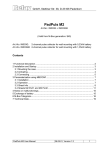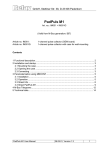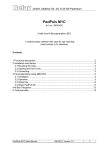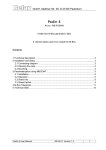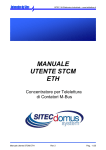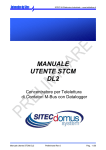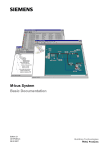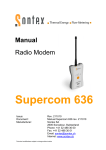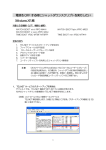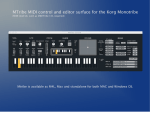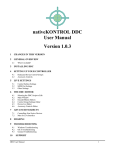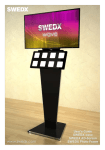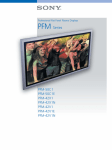Download PadPuls M4L User Manual
Transcript
GmbH, Stettiner Str. 38, D-33106 Paderborn PadPuls M4L Art.No.: IM002G (Valid from M-Bus generation: $12) Art.-No. IM002G: 4-channel pulse collector for wall / rail mounting Contents 1 Functional description...................................................................................................2 2 Installation and Startup .................................................................................................3 2.1 Opening the case ...................................................................................................3 2.2 Activating ...............................................................................................................3 2.3 Connecting.............................................................................................................4 2.4 Mounting ................................................................................................................6 3 Parameterization using MBCONF ................................................................................7 3.1 Installation..............................................................................................................7 3.2 Operation ...............................................................................................................7 3.3 Sheet Info...............................................................................................................8 3.4 Sheets M4 Port1 to M4 Port4...............................................................................11 4 Notes on malfunctionings ...........................................................................................15 5 M-Bus Telegrams .......................................................................................................16 6 Technical Data............................................................................................................19 PadPuls M4L User Manual 24.09.01, Version 1.4 1 GmbH, Stettiner Str. 38, D-33106 Paderborn 1 Functional description The PadPuls M4L serves for the adaptation to the M-Bus system of consumption measuring instruments, such as, current, gas or water meters. However, the meters to be adapted must have a floating pulse output. Up to four impulse meters can simultaneous be connected to the inputs of this device. Optionally the user can activate a tariff function, by which energy or volume pulses are accumulated in separate meter readings for primary and secondary tariffs. In this case a floating signal for tariff switch is used at Port 2 and / or Port 4. Each port or each tariff of the PadPuls M4L can be read on M-Bus using its own primary and secondary address. The PadPuls M4L thus acts as four stand-alone M-Bus Slaves! The user configures the pulse collector with the software MBCONF. The accumulated pulses are converted into kWh, m3, J or other physical units. The user interface of MBCONF allows the operator to get an easy access to the configuration. Alternatively the communication and configuration can be done using the optical interface of the pulse adapter. It is also suited for mobile reading with a handheld or laptop and an optical reading head. When connected to the M-Bus the PadPuls M4L is powered from the bus. A built-in battery ensures that metering continues if the M-Bus is interrupted. Another feature of the PadPuls M4L is the due-date function. Meter data are saved separately at the preset due-date at 00:00 hour (day change to the due-date) by the implemented clock with calendar function. The due-date can be changed without lost of the already stored counters. Additionally the M-Bus Master can initiate an immediate execution of the due-date function by sending of the so-called „Freeze“ command. A „Freeze“ sent to all pulse collectors using the broadcast address 254 is helpful for generating reading profiles of an M-Bus system. Afterwards the master software polls the data of all meters. The complete configuration data is saved into a non-volatile memory (EEPROM). Additional security is provided by daily saving of meter readings into this EEPROM. In case of M-Bus fail and empty battery the last saved data is restored on power up. The configuration data can be protected against unauthorized manipulation. The PadPuls M4L can therefore be switched to protection mode with a special M-Bus telegram. Subsequent changes to device parameters cannot be made in this operating mode. The protection mode can then only be disabled by opening the sealed housing and pressing the unprotect pushbutton for minimum 4 seconds. 2 24.09.01, Version 1.4 PadPuls M4L User Manual GmbH, Stettiner Str. 38, D-33106 Paderborn 2 Installation and Startup 2.1 Opening the case The case cover can be removed from the lower housing half with the help of a small screwdriver. The screwdriver is placed, as in the drawing, into the small opening at the cover side. After light moving of the screwdriver in the displayed direction the cover can be taken off. 2.2 Activating Coming from factory the PadPuls M4L must first be activated. The housing must be opened (see drawing) and the jumper has to be placed on both pins. Then battery operation and data saving is activated on M-Bus failure. On the back of the PadPuls M4L board there are the follwing control elements: If the device is not used for a longer time, it is advisable to deactivate battery operation by removing the jumper to preserve the battery. PadPuls M4L User Manual 24.09.01, Version 1.4 3 GmbH, Stettiner Str. 38, D-33106 Paderborn 2.3 Connecting The following figure shows the link of four counters with impulse outputs to the PadPuls M4L. We recommend to use 2-wire cables (twisted pair, NYM or j-Y(St)Y) with a max. length of 10m. In any case it must be noted that the total capacity of the cable plus impulse generator attached at any port may not exceed 2nF (optional 12nF with activated “long pulse sampling”). M-Bus PadPuls M4L 001234,3 001234,3 001234,3 001234,3 m3 m3 m3 m3 • If not all ports of PadPulse M4L are used, you should not attach a cable to the respective unused port. The capacity of an open-circuited cable reduces the lifetime of the battery in stand-alone operation (no M-Bus available). • If the pulse frequency is over 14 Hz, false countings can occur. 4 24.09.01, Version 1.4 PadPuls M4L User Manual GmbH, Stettiner Str. 38, D-33106 Paderborn The following graph represents the diagram of connections in the tariff mode with two counters and two tariff signal generators: M-Bus PadPuls M4L Tariff B 001234,3 001234,3 m3 m3 Pulses B Tariff A Pulses A The PadPuls M4L is supplied from M-Bus if it is available. In this normal state the internal battery is then not loaded. Only when the M-Bus fails the battery takes over automatically the supply. There is no lost of data and the counting function is continued. The PadPuls M4L draws approximately 2.75mA current ( maximum 2 unit loads) from the M-Bus. PadPuls M4L User Manual 24.09.01, Version 1.4 5 GmbH, Stettiner Str. 38, D-33106 Paderborn 2.4 Mounting On the back of the housing there is a special mechanism for mounting the device on a DIN rail according to DIN EN 50022. This mechanism can be removed, turned over and fixed on the wall with two screws. Afterwards you can mount the device without using a rail. The following figures show the two options: Rail mounting 6 Wall mounting 24.09.01, Version 1.4 PadPuls M4L User Manual GmbH, Stettiner Str. 38, D-33106 Paderborn 3 Parameterization using MBCONF The configuration of the device must be adapted by the customer to the respective installation. The current version $12 of PadPuls M4L requires the use of the program MBCONF for configuration. The older DOS version PADCON may not be used anymore. 3.1 Installation The software MBCONF for configuration of the pulse adaptor is a 32-bit application, which can be executed on IBM-PC compatible computers under the operating systems Windows 95 / 98 / NT 4.0. The desktop PC or laptop must have a free serial RS232C interface to connect the M-Bus level converter. The PadPuls M4L to be parameterized must be connected directly (i.e. as only M-Bus device) to the M-Bus output of the level converter. Please start the file “MBCONF_SETUP.EXE” from Windows Explorer or via “Start – Execute” to install the software from version 1.40 up. Subsequently you select the language of the installation procedure. The setup software can create a program group and a link on the desktop on demand. You can then execute both versions for German and English language either from start menu or desktop. 3.2 Operation After program start the user operates the software according to the Windows conventions with the mouse or the keyboard. If you stay with the mouse on a button or an input field, then a hint to its function appears. Light-grey fields and boxes are not capable for editing. All input fields and buttons have an underlined letter. The function can be activated by simultaneous pressing of the keys [ALT] and the respective letter. Within dialogs the cursor can be moved with the keys [TAB] or [SHIFT][TAB ] forwards and back. [SPACE ] activates or deactivates selection boxes. Multiple selection boxes (arrow at the right edge) can be activated with [⇓]. The user then selects an entry with [⇓] and [⇑]. By pressing [RETURN] the selected entry is taken over. With [ESC] the selection box is left without transfer. The program is arranged as a sheet system. The sheet “Info” contains general options of the communication with the M-Bus device to be configured. In this sheet the user can select the serial port of the PC, the baudrate of the PC, the baudrate of the M-Bus device and the M-Bus primary address which is used for communication. After a successful connection with the M-Bus device, further manufacturer information is shown in the sheet “Info” and additional device-specific sheets are displayed. PadPuls M4L User Manual 24.09.01, Version 1.4 7 GmbH, Stettiner Str. 38, D-33106 Paderborn 3.3 Sheet Info This sheet shows some photos of supported M-Bus devices from the product range of the Relay GmbH, the PadMess GmbH and further manufacturer. Here are also links to the Internet page, from which the current version of the program can be downloaded, and to the email address for criticism and suggestions to the program. The lower third of this card is likewise visible in every other card. Here the following input fields and buttons are always attainable: COM-Port is the serial port of the PC to which the M-Bus level converter is connected. The selected port will be saved in an INI file and will be restored on startup. Therefore the COM-Port has to be configured only once. Baudrate ist the transmission speed of the serial port of the PC used for parameterization. Possible selections for this used M-Bus baudrate are 300, 2400 or 9600 baud. Attention: Baudrates of more than 8 24.09.01, Version 1.4 PadPuls M4L User Manual GmbH, Stettiner Str. 38, D-33106 Paderborn 2400 baud are not supported by all M-Bus level converters which are available on the market! The selected baudrate must be identical to the baudrate of the M-Bus device. (see: “New M-Bus Baudrate”). The PadPuls M4L supports the baudrates 300 and 2400 Bd. New M-Bus Baudrate allows reprogramming the baudrate of the M-Bus device. The new baudrate is sent to the M-Bus device after a change in the appropriate selection box. If the M-Bus slave accepts this command, it acknowledges the telegram with the single character „$E5“ ($ for hexadecimal notation) using the old baudrate. Afterwards the device switches to the new baudrate. This button is not needed for the PadPuls M4L, since it automatically detects the baudrate used by the master. M-Bus Address is the primary address of the connected M-Bus slave. In a direct connection with only one slave you can use the broadcast address 254. Using this address every M-Bus device must answer regardless of its own address. Connect to meter is used to request data from the slave. The type of device is then automatically recognized. The items “Manufact.”, “Generation”, “Type” and “M-Bus State” will then be refreshed. New sheets are generated depending on manufacturer and type of the M-Bus device. A single sheet for each channel appears in case of PadPuls M4L. The sheets are labelled “M4 Port1” for the first … “M4 Port4” for the fourth channel. Manufact. is an item that shows the 3-letter manufacturer code after successful reading (“Connect to meter”). The item is read only. Generation shows the software revision of the firmware of the connected MBus device. The item is read only. Type shows the type (here: PadPuls M4) of the connected device. This item is read only. M-Bus State shows the M-Bus state of the connected device. This item is read only. ZVEI optical mode If this option is activated, devices with an optical interface and protocol according to EN 1434-3 can be read and programmed using an optical reading head (e.g. PadPuls M4 / M4L). Autom. readout The software always reads the data after writing, if this option is activated (useful for checking the correct programming). PadPuls M4L User Manual 24.09.01, Version 1.4 9 GmbH, Stettiner Str. 38, D-33106 Paderborn Log-Window The so-called log window is always visible. All M-Bus communication steps are logged in this window. Data is displayed in hexadecimal notation. It is possible to mark outputs in the log window and copy them with the keys “CTL-C” to the windows clipboard. Then the data can be easily imported to any text editor for documentation. As soon as the max. storage capacity of the window is achieved, no more data is logged. If you want to log further, you must delete the logged data. The following buttons are also always visible: Erase log clears all outputs inside the log window. Exit terminates the program and stores the current setting of serial port (port no.) into the INI file. 10 24.09.01, Version 1.4 PadPuls M4L User Manual GmbH, Stettiner Str. 38, D-33106 Paderborn 3.4 Sheets M4 Port1 to M4 Port4 These sheet shows the current settings and values of the respectively pulse channel (port) of the PadPuls M4L (in this example: Port 1). The following input boxes and buttons are used to change the params of the pulse adapter: Primary address is the M-Bus address of the selected port. Values between 1 and 250 can be entered in this field for new assignment of the address. After pressing the “Write” button the software programs this primary address and further variable settings on this sheet into the M-Bus device. ID (sec. adr.) is the 8 digit M-Bus ID (identification no.), which is also used for secondary addressing of this port. Medium describes the measured medium of the connected meter. Examples: Oil, Water, Heat, Electricity PadPuls M4L User Manual 24.09.01, Version 1.4 11 GmbH, Stettiner Str. 38, D-33106 Paderborn Multiplicator is the pulse increment (multiplicator) of the connected meter. For each registered pulse the device adds “multiplicator” to the counter. The numerator can take values between 0 (no counting) and 99, the denominator between 1 and 256. Unit is the physical unit of the counter and of the pulse increment. All proper units including variants with power of ten from the DIN EN 1434-3 are offered in the selection list. Counter is the accumulated counter. It has to be related to the unit mentioned above. The counter can be programmed equal to the counter of the connected meter in a range of 0 to 99999999. Current time is the current date and time-of-day of the internal clock in the format DD.MM.YY_hh.mm. This field can be only edited and modified in the PadPuls, if the switch “Edit and change time” is activated. The button “Read clock of PC” transfers once the current date and time of the PC into this window. The time-of-day and the date always apply to all ports of PadPuls M4L. Due-date is the last due-date (date of the last storage of the due-date counter) in the format DD.MM.YY. This field is read only. Due-date cnt. is the counter which was saved at the due-date. This field is read only. Next Due-date is the next (future) due-date (date of the next storage of the counter) in the format DD.MM.YY. The counter will be saved at 00:00, e.g. with due-date 01.01 at change from 31th of December 23:59 to 1st of January 00:00. This field can be edited and programmed only, if the switch “Edit and change time” is marked. The due-date always applies to all ports of PadPuls M4L. State of ports shows the current input state of all ports (a closed contact is marked). This item is read only. Write protection is marked, if the device is protected against programming. Then you cannot configure the adapter. The protection can be removed after opening the sealable housing and pressing the “Unprotect” pushbutton for a minimum of 4 seconds. EEPROM error is marked, if there was an error while reading the non-volatile memory. In this case you must reconfigure the device. 12 24.09.01, Version 1.4 PadPuls M4L User Manual GmbH, Stettiner Str. 38, D-33106 Paderborn Tariff A (P1/2) is used for activation tariff mode on port 1 and 2. The tariff mode will be selected after pressing the “Write” button, if the check box is marked. Port 1 is then used as pulse input and port 2 is the tariff switch. With an open tariff switch the pulses are accumulated to the counter for port 1 (main tariff). With a closed tariff contact the pulses increment the counter for port 2 (special tariff). Tariff B (P3/4) is used for activation tariff mode on port 3 and 4. The tariff mode will be selected after pressing then “Write ” button, If the check box is marked. Port 3 is then used as pulse input and port 4 is the tariff switch. With an open tariff switch the pulses are accumulated to the counter for port 3 (main tariff). With a closed tariff contact the pulses increment the counter for port 4 (special tariff). Long pulse sampling activates a longer charging of the contacts before sampling the inputs. This allows higher capacitors and / or many pulse generators with So interface (photocoupler with capacitors) to be connected. On delivery the extended pulse sampling is activated. The lifetime of battery is increased for about 15% if this feature is not used. Edit and change activation of this check box allows editing and programming of the “Current time” and “Next due-date”. The checkbox is deactivated time automatically after successful configuration with “Write”. Freeze transmits a command to the PadPuls M4L telling it to freeze the counters. The PadPuls M4L then copies the current counter to the “Due-date counter” and the current date to the (last) “Due-date”. The storage is done for all ports simultaneously. This the same behaviour as at due-date. The freeze command can be used with the broadcast address 255 to order all PadPuls to save the current counters. Then the M-Bus master has enough time to read all meters and get values of the same time (reading profiles). Read clock of PC once gets the current date and time from the clock of the PC and transfers it into the item “Current time”. Write protect Transmits a command to the PadPuls M4L to activate write protect. The PadPuls M4L then allows no further configuration. It is protected against unnoticed manipulation. PadPuls M4L User Manual 24.09.01, Version 1.4 13 GmbH, Stettiner Str. 38, D-33106 Paderborn Read reads the M-Bus device and refreshes the data on the selected sheet. Write sends the current options to the pulse converter, which saves this data into the non-volatile memory. The PadPuls M4L changes the options only if the write protect is deactivated. It is recommended to read the data after writing and check it. Notes: 1. The variables „Current time“, „Next due-date“, „Write protection“, „Long pulse sampling “ and the command „Freeze“ always apply to all ports. Therefore you need to edit these items only in one sheet. The write protect should be activated after successful configuration of all ports. 2. Please press first the button „Connect to meter“ after connecting a new M-Bus device. Afterwards all sheets are refreshed. 3. Examples for configuration of pulse increment and unit: • Water meter with counter = 45120 l and 1 Pulse = 10 l: Choice 1: Unit = 10 l, Multiplicator = 1 / 1, Counter = 4512 ( x 10 l) Choice 2: Unit = 1 l, Multiplicator = 10 / 1, Counter = 45120 ( x 1 l) • Electricity meter with counter = 78346 kWh and 64 pulses / kWh: Choice: Unit = 1kWh, Multiplicator = 1 / 64, Counter = 78346 ( x 1kWh) • Electricity meter with counter = 112,345 kWh and 1000 pulses / kWh: Choice: Unit = 1Wh, Multiplicator = 1 / 1, Counter = 1123454 ( x 0,001Wh) 4. With activated tariff option the pulses are evaluated with the adjustments of the respective port. Therefore you should take care that both ports have the same pulse increment and unit. 14 24.09.01, Version 1.4 PadPuls M4L User Manual GmbH, Stettiner Str. 38, D-33106 Paderborn 4 Notes on malfunctionings Error No function in battery mode No function after installation, although the battery jumper is placed and the MBus is connected Pulses are not counted or wrong - - - PadPuls M4L User Manual Possible source of error Battery jumper is not placed Battery is empty (voltage min. 2.9V) After placing the jumper a reset is generated using an R/C combination. It is possible that the reset was not correct. Please lift the jumper, wait about 10 seconds and place it again. Check connection of the pulse meter Activate the „extended pulse sampling” if your system has: a) long cables (> 10m) b) high capacitors c) electronic S0 interface Check configuration (especially pulse increment and tariff mode) 24.09.01, Version 1.4 15 GmbH, Stettiner Str. 38, D-33106 Paderborn 5 M-Bus Telegrams Position 1 2 Name: Start Value (hex): 68 2F 13 14 15 Man1 Gen Med 3 4 5 6 7 8 9 10 11 12 Start C A CI ID0 ID1 ID2 ID3 Man0 2F 68 08 16 17 18 19 20 21 TC State Sig0 Sig1 DIF1 VIF1 00 00 0C Length Length 48 72 AC 22 23 24 25 Stand0 Stand1 Stand2 Stand3 28 29 30 31 32 33 34 35 36 37 VIF2 Date0 Date1 Date2 Date3 DIF3 VIF3 LeStD0 LeStD1 DIF4 VIF4 42 6C 46 47 48 49 50 51 52 53 DIF6 Info Numer ator Denomi nator PStat CS Stop 41 42 43 StStn3 DIF5 VIF5 42 EC 44 45 VIFE5 StDat0 StDat1 7E DIF2 04 27 6D 26 38 39 40 StStn0 StStn1 StStn2 4C 0F 16 RSP_UD telegram A: ID0-3: Man0-1: Gen: Med: TC: State: VIF1=VIF4: Stand: Date: LeStD: StStn: StDat: Info: Numerator: Denominator: PStat: 16 primary address identification no. for secondary addressing manufacturer code revision of firmware (at this time $12, reserved range: $10 .. $1F) medium transmission counter (number of transmitted RSP_UD) most significant bit set (bit 7) -> write protected bit 3 set (permanent error) -> error in EEPROM data selected VIF (value information field -> physical unit) current counter current date (IEC870-5-4: data type F) last due-date, date of the due-date counter (IEC870-5-4: data type G) due-date counter next (future) due-date 1 byte with information about tariff and sampling method) numerator of pulse increment(1..99) denominator of pulse increment (1..255, 0 -> 256) Numerator 1 Pulse = ∗ VIF Deno min ator state of inputs (current input state of the ports) 24.09.01, Version 1.4 PadPuls M4L User Manual GmbH, Stettiner Str. 38, D-33106 Paderborn Byte 48 (Info) Bit 7 6 5 4 3 2 1 0 Value (bin) x Sampling Tariff B Tariff A 0 0 Select1 Select0 Select: Tariff A: Tariff B: Sampling: number of the port, for which the data is valid 00: Port1, 01: Port2, 10: Port3, 11:Port4 tariff A (Port 1 = count input, Port2 = counter / tariff signal) 0: tariff off (Port2=count input), 1: tariff on (Port2=tariff signal) tariff B (Port 3 = count input, Port4 = counter / tariff signal) 0: tariff off (Port3=count input), 1: tariff on (Port4=tariff signal) duration of a sampling 0: short (0.5ms), 1: long (1.5ms) Position 1 Name: Start Value (hex): 68 13 14 15 16 PAdr DIF3 VIF3 ID0 07 79 28 29 27 Stand1 Stand2 Stand3 41 Opt. 42 43 Numer Deno ator minat. 2 3 4 5 6 7 8 9 10 11 12 Start C A CI DIF1 VIF1 Anw. DIF2 VIF2 68 53 51 01 7F 01 7A 17 18 19 20 21 22 23 24 25 26 ID1 ID2 ID3 Man0 Man1 Gen Med DIF4 VIF4 Stand0 AC 48 39 40 Length Length 0C 30 31 32 33 34 35 36 37 DIF5 VIF5 Date0 Date1 Date2 Date3 DIF6 VIF6 04 6D 42 6C 44 45 CS Stop 38 StDat0 StDat1 DIF7 0F 16 SND_UD telegram (Abbreviations see RSP_UD) Port: seleced port (used with address 254) 0=Port1, 1=Port2 PAdr: new primary address of the port Numerator: Numerator of pulse increment (1..99, BCD format) Denominator: Denominator of pulse increment (1..255, 0 -> 256, binary fromat) Option: Options (tariff, sampling). Coding like Info (Byte 48 RSP_UD). The PadPuls M4L analyzes the individual data records on the basis of the DIF. Therefore the order of the records is allowed to vary. It is also possible to transmit only parts of the SND_UD specified above. The manufacturer-specific appendix of the telegram is always first analysed and must be included therefore in any case. The optional record „DIF1 VIF1 Anw“ selects a port to be addressed with global address 254. This must be always the first record in the telegram. PadPuls M4L User Manual 24.09.01, Version 1.4 17 GmbH, Stettiner Str. 38, D-33106 Paderborn Position 1 Name: Start Value (hex): 68 2 3 Length Length 05 05 4 5 6 7 8 9 10 11 Start C A CI DIF Prot. CS Stop 68 53 51 0F 55 16 Protection-Telegram This telegram activates the write protection. Position 1 Name: Start Value (hex): 68 2 3 4 5 6 7 8 9 10 11 Start C A CI DIF Anw. CS Stop 05 68 53 51 0F 3 4 5 6 7 8 9 10 11 Start C A CI DIF VIF Anw. CS 68 53 51 01 7F Length Length 05 16 Select telegram (old method) Position 1 Name: Start Value (hex): 68 2 Length Length 06 06 12 Stop 16 Select telegram (new method) Anw. specifies the Port of the PadPuls M4L, which answers to a REQ_UD2 at address 254: Port1: Anw=00 Port2: Anw=01 Port3: Anw=02 Port4: Anw=03 Position 1 Name: Start Value (hex): 68 2 3 Length Length 03 03 4 5 6 7 8 9 Start C A CI CS Stop 68 53 54 16 Freeze telegram On reception of this telegram the pulse adapter saves the current counters of all ports into the due-date counters and the current date into the due-date. 18 24.09.01, Version 1.4 PadPuls M4L User Manual GmbH, Stettiner Str. 38, D-33106 Paderborn 6 Technical Data Case Mounting DIN rail according to DIN EN 50022 or wall Material ABS plastic Colour light-grey (similar RAL 7035) WxHxD (55 x 75 x 105) mm Protection type IP40 Environment Operating temperature 0 to 55 °C Storage temperature -20 to 60 °C Humidity (non condensing) 10% to 70% Specifications to contacts of pulse generators Potential floating, insulation to earth > 1MΩ Resistance open > 1MΩ, closed < 2kΩ Maximum capacity (incl. cable) 2nF (short sampling), 12nF (long sampling) Minimum contact duration 30 ms Minimum pause between contacts 30 ms Maxium pulse frequenz 14 Hz Specifications to contact of tariff generator Potential floating, insulation to earth > 1MΩ Resistance open > 1MΩ, closed < 2kΩ Maximum capacity (incl. cable) 2nF (short sampling), 12nF (long sampling) Possible signal wave forms 50 / 60 Hz or static signals PadPuls contact input: Contact voltage 2.5V to 3.6V Contact current 30 µA Guaranteed debounce time 5.0 ms Connection cable maximum 10 m (Twisted Pair recommended) PadPuls M4L User Manual 24.09.01, Version 1.4 19 GmbH, Stettiner Str. 38, D-33106 Paderborn Current consumption Principle remote power supply from M-Bus with automatic changeover to battery on bus failure Bus operation max. 3.0 mA ( 2 unit loads), no battery loading Battery standard optional Lithium 3V, type 2/3 AA, 1800mAh, exchangable Lithium 3V, type C, 5000mAh Battery operation at 25°C ca. 60µA (long sampling) Battery lifetime in battery operation standard battery: optional battery: Short sampling Battery lifetime is lengthened by ca.15% if short sampling is activated. at 25°C ca. 3 years at 25°C ca. 8 years M-Bus: physical characteristics M-Bus quiescent current typ. 2.75 mA, max. 3.0 mA (2 unit loads) Space(0-Bit) current quiescent current (1.4 mA) + typ. 13 mA M-Bus Interface TI TSS721 with 2 x 215Ω protection resitors M-Bus Protocol Standard EN1434-3 Transmission speed 300, 2400 baud with automatic detection Addressing Primary- and secondary addressing with wildcards, per input port : 1 primary and 1 secondary address Supported functions SND_NKE, REQ_UD2, SND_UD, ignores FCB-Bit (according to EN1434-3) Data structure variable structure, Low-Byte-First (CI: 72h) length = 53 Bytes 1. data record: counter 2. data record: date and time 3. data record: last due-date 4. data record: last due-date counter 5. data record: next due-date 6. data record: manufacturer specific data Configuration telegram Identification no., medium, primary address, pulse increment, pulse unit, initial counter, tariff mode, date / time and next due-date: can be parameterized via SND_UD through M-Bus or optical interface 20 24.09.01, Version 1.4 PadPuls M4L User Manual




















